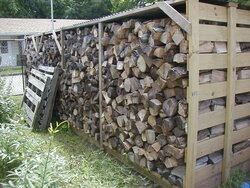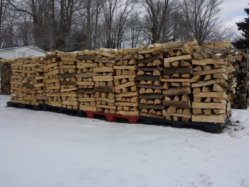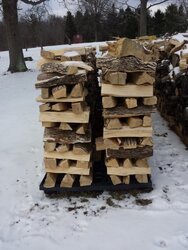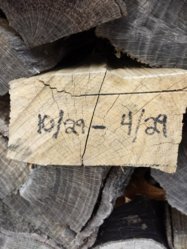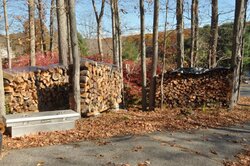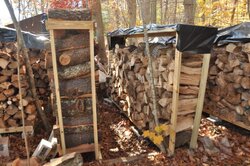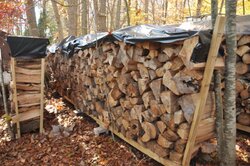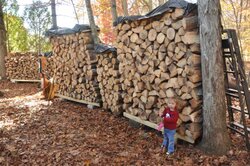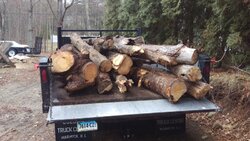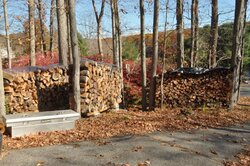Hello everyone,
This is my first year burning a wood stove... well wood burning insert. I thought that I planned ahead and bought wood in august. Bought from two different sources one of which was highly recommend to my by a family friend. I also, had just about 1/2 cord of wood left over from last year from burning in an open fireplace before making up my mind to get an insert. It has been really quite mild around me this year so I am just getting to the wood that I bought this year. I found the insert was burning differently and discovered that my wood was not seasoned well at all. 30-35% The one smart think I did was buy enough wood so that I would have enough for next year. I was reading you want to keep at least one year ahead and season it yourself that way you know that it is right. So this year I am scrambling to find dry wood in my stack which I think I can make it through. I am currently trying to plan for this coming spring and summer.
I was thinking in the beginning of spring I would take my 3 cords of wood that I will have left from this year out of 3 rows and line them up along my fence line in one row. Most of my property doesn't get sun all day but where I plan on stacking it should get sun all morning to mid afternoon.
I have been trying to find information on wood sheds and have been reading posts that are already up. My intension is to build one this year but don't know how big of one will be needed. I am not using wood to heat my house by its self. I have an HVAC system that is my primary source. That being said I will probably be using around 2 cords of wood a year. Should I make my shed big enough to handle 4 cords? I was reading people season wood in the open and put it in the shed in prep for winter. In this case I plan on having next years wood this year so that I am always a year ahead to make sure it is good and seasoned. Should I leave next years wood out in the open until next fall then load it up in shed? Or should I put in shed and bring out next year for seasoning? Also if I keep out and I am seasoning it in spring/summer should I cover it? Some say yes but others say no keep it open; that the rain doesn't have an effect on seasoning as it only gets the outer layer wet. I also have questions on directions n,s,e,w on how to orient the shed or if this matters at all.
I am sure I will have more questions but wanted to keep the novel somewhat short as I know no one wants to read a dissertation of a post. btw my wood is all hard wood oak, cherry, maple, birch, ash mostly. I know I may have issues with the oak taking longer to season.
This is my first year burning a wood stove... well wood burning insert. I thought that I planned ahead and bought wood in august. Bought from two different sources one of which was highly recommend to my by a family friend. I also, had just about 1/2 cord of wood left over from last year from burning in an open fireplace before making up my mind to get an insert. It has been really quite mild around me this year so I am just getting to the wood that I bought this year. I found the insert was burning differently and discovered that my wood was not seasoned well at all. 30-35% The one smart think I did was buy enough wood so that I would have enough for next year. I was reading you want to keep at least one year ahead and season it yourself that way you know that it is right. So this year I am scrambling to find dry wood in my stack which I think I can make it through. I am currently trying to plan for this coming spring and summer.
I was thinking in the beginning of spring I would take my 3 cords of wood that I will have left from this year out of 3 rows and line them up along my fence line in one row. Most of my property doesn't get sun all day but where I plan on stacking it should get sun all morning to mid afternoon.
I have been trying to find information on wood sheds and have been reading posts that are already up. My intension is to build one this year but don't know how big of one will be needed. I am not using wood to heat my house by its self. I have an HVAC system that is my primary source. That being said I will probably be using around 2 cords of wood a year. Should I make my shed big enough to handle 4 cords? I was reading people season wood in the open and put it in the shed in prep for winter. In this case I plan on having next years wood this year so that I am always a year ahead to make sure it is good and seasoned. Should I leave next years wood out in the open until next fall then load it up in shed? Or should I put in shed and bring out next year for seasoning? Also if I keep out and I am seasoning it in spring/summer should I cover it? Some say yes but others say no keep it open; that the rain doesn't have an effect on seasoning as it only gets the outer layer wet. I also have questions on directions n,s,e,w on how to orient the shed or if this matters at all.
I am sure I will have more questions but wanted to keep the novel somewhat short as I know no one wants to read a dissertation of a post. btw my wood is all hard wood oak, cherry, maple, birch, ash mostly. I know I may have issues with the oak taking longer to season.


